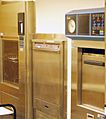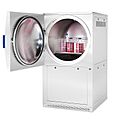Autoclave facts for kids
An autoclave is a special machine that uses super hot steam under high pressure to clean things. It's like a super-powered pressure cooker! This extreme heat and pressure kill all tiny living things, like germs and organisms, that you can't see. This process is called sterilization. It makes sure that tools and equipment are completely safe and clean to use, especially in hospitals and labs. The first autoclave was invented by Charles Chamberland in 1879.
Contents
What is an Autoclave?
An autoclave is a device that uses pressure to heat liquids and other objects. It heats them to temperatures much higher than the normal boiling point of water. This is done to kill all microscopic living things. These tiny living things include bacteria, viruses, and fungi. Killing them makes sure everything is completely clean and safe. This important process is called sterilization.
How Does an Autoclave Work?
Autoclaves work by creating a very hot and high-pressure environment. First, items to be sterilized are placed inside the machine. The door is then sealed tightly. Next, water inside the autoclave is heated to create steam. This steam is then pumped into the main chamber.
High Heat and Pressure
The steam inside the autoclave reaches very high temperatures. It can get much hotter than boiling water, usually around 121 to 134 degrees Celsius (250 to 273 degrees Fahrenheit). At the same time, the pressure inside the autoclave increases a lot. This high pressure helps the steam get into every tiny space. It also helps the heat kill all germs quickly and effectively.
Killing Germs
The combination of high heat and pressure is very powerful. It destroys the cells of bacteria, viruses, and other microorganisms. This makes them unable to cause sickness or spread infections. After a set amount of time, the steam is released. The sterilized items can then be safely removed.
Why Are Autoclaves Important?
Autoclaves are very important in many different places. They help keep people safe and healthy.
In Hospitals and Clinics
In hospitals, doctors and nurses use autoclaves to sterilize surgical tools. They also sterilize medical equipment and dressings. This stops the spread of infections between patients. It makes sure that every procedure is as safe as possible.
In Laboratories
Scientists in laboratories use autoclaves too. They sterilize lab equipment like test tubes and beakers. They also sterilize special liquids used for growing microorganisms. This prevents unwanted germs from affecting their experiments. Autoclaves are also used to safely get rid of waste that might contain harmful germs.
Other Uses
Autoclaves are not just for hospitals and labs. They are also used in other industries. For example, some food companies use them to sterilize canned foods. This helps the food stay fresh for a long time. Even some tattoo and piercing studios use small autoclaves. They sterilize their needles and tools to protect their clients.
Types of Autoclaves
There are different kinds of autoclaves, from small ones you can put on a stovetop to very large machines.
Stovetop Autoclaves
The simplest autoclaves are like pressure cookers you might see in a kitchen. These are often called stovetop autoclaves. They are small and good for sterilizing small items at home or in very small clinics.
Laboratory and Medical Autoclaves
Larger autoclaves are found in hospitals and research labs. These machines can sterilize many items at once. Some are designed to be loaded from the front. Others are "pass-through" autoclaves. These allow items to be loaded on one side and removed from a clean room on the other. This helps keep sterile and non-sterile areas separate.
Images for kids
-
Sterilization bags often have a "sterilization indicator mark" that typically darkens when the bag and its contents have been adequately processed. Comparing the marks on an unprocessed bag (L) and on a bag that has been properly cycled (R) will reveal an obvious visual difference.
-
Stovetop autoclaves, also known as pressure cooker—the simplest of autoclaves
See also
 In Spanish: Autoclave para niños
In Spanish: Autoclave para niños








